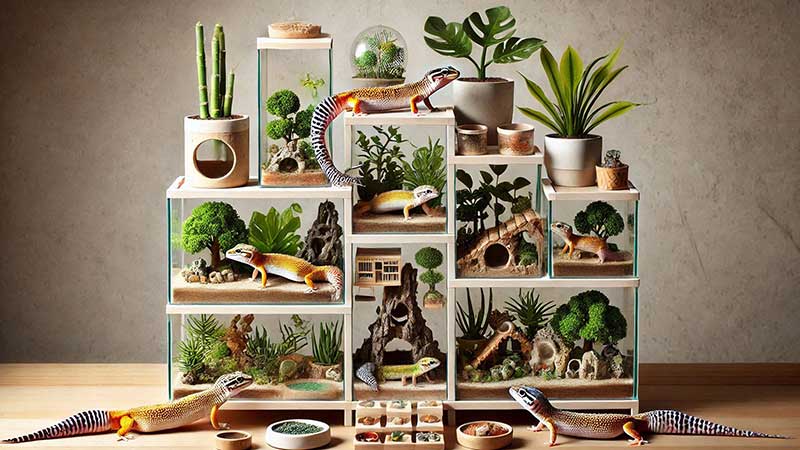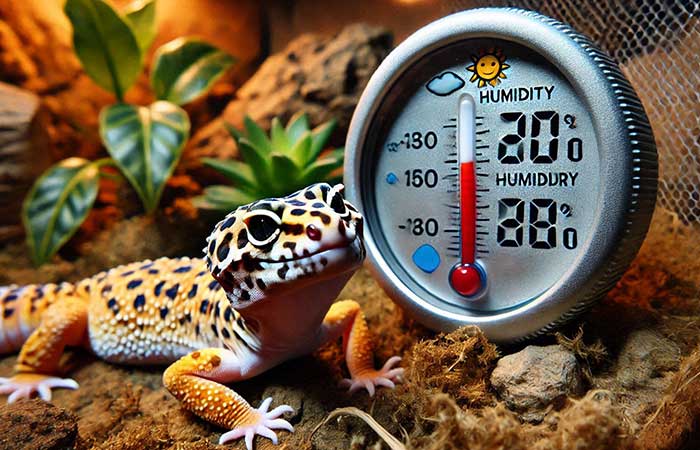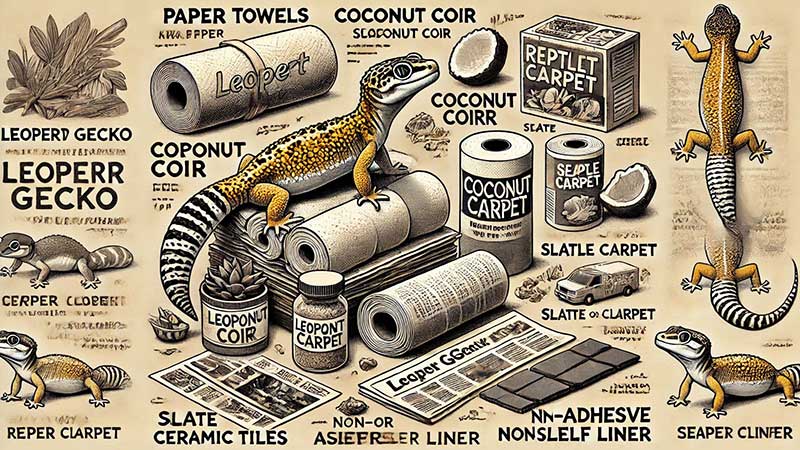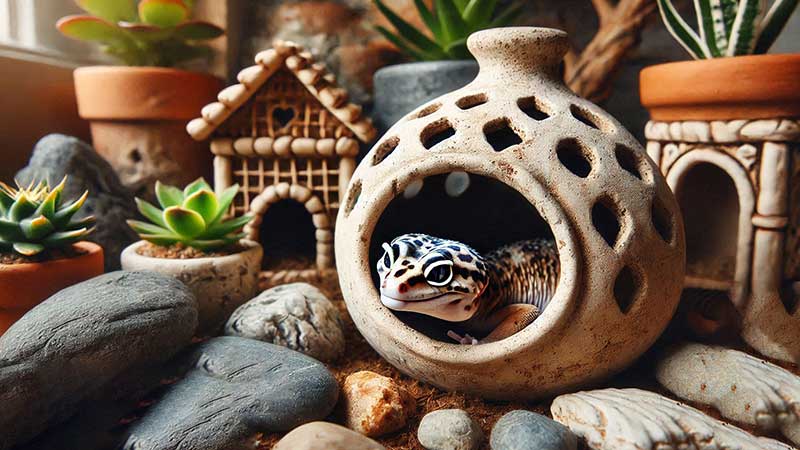Setting up the perfect leopard gecko habitat is crucial for ensuring your reptilian companion thrives in their new home. Furthermore, a properly designed enclosure not only promotes optimal health but also encourages natural behaviors that keep your gecko active and engaged. In fact, many common health issues can be prevented simply by creating the right environmental conditions from the start.
Why Proper Habitat Setup Matters

Your leopard gecko’s habitat directly influences their overall well-being, from proper digestion to healthy shedding cycles. Moreover, these fascinating creatures have evolved specific environmental needs that must be replicated in captivity. Subsequently, investing time and resources in the right setup will save you both money and potential veterinary visits in the long run.
Before diving into the specific components, let’s understand the essential elements every leopard gecko habitat must include:
- A properly sized enclosure with adequate ventilation
- Distinct temperature zones for thermoregulation
- Appropriate lighting for day/night cycles
- Multiple hiding spots for security
- Safe substrate that supports natural behaviors
- Proper humidity levels with a moisture gradient
Understanding these foundational requirements is crucial because they work together to create a balanced environment. Additionally, each element plays a vital role in supporting your gecko’s physical and behavioral needs. Therefore, cutting corners on any of these aspects can impact your pet’s long-term health and happiness.
Getting Started: Basic Setup Overview
Before purchasing equipment and accessories, it’s essential to plan your setup carefully. Consequently, this helps ensure you make informed decisions about product selection and placement. First and foremost, consider the space where you’ll keep your gecko’s enclosure. The location should be:
- Away from direct sunlight and drafts
- In a room with stable temperatures
- On a sturdy, level surface
- Easily accessible for daily maintenance
- Protected from other pets and excessive noise
With these fundamentals in mind, we can now explore each component of your leopard gecko’s habitat in detail. Subsequently, we’ll start with one of the most important decisions: choosing the right enclosure size and style for your pet.
Choosing the Right Enclosure

Selecting an appropriate enclosure is the foundation of your leopard gecko habitat. Therefore, it’s crucial to choose a terrarium that provides adequate space for movement, temperature regulation, and natural behaviors. Moreover, the right enclosure size ensures your gecko can properly exercise and maintain good health.
Recommended Enclosure Sizes
While many pet stores might suggest smaller tanks, experienced keepers recommend these minimum sizes:
- Single Adult Gecko: 20-gallon tank (30″ x 12″ x 12″)
- Breeding Pair: 30-gallon tank (36″ x 12″ x 16″)
- Growing Juvenile: 10-gallon tank (20″ x 10″ x 12″)
A high-quality terrarium provides the perfect foundation for your leopard gecko’s home. Furthermore, investing in a properly sized enclosure from the start saves money on future upgrades.
Front-Opening vs. Top-Opening Enclosures
When choosing between enclosure styles, consider these key differences:
- Front-opening terrariums reduce stress during maintenance
- Top-opening tanks often cost less but can frighten geckos during access
- Front-opening designs provide better ventilation options
- Traditional tanks may require additional modifications for proper airflow
Essential Enclosure Features
Look for these important features when selecting your gecko’s new home:
- Secure screen top for ventilation
- Escape-proof design with tight-fitting doors or lid
- Easy access for cleaning and maintenance
- Sufficient depth for substrate and decorations
- Space for necessary heating and lighting equipment
Another crucial consideration is the enclosure’s material. Subsequently, glass terrariums offer excellent visibility and heat retention, while PVC enclosures provide better insulation. Additionally, screen tops allow for proper ventilation but can make maintaining proper temperatures more challenging in colder rooms.
Positioning Your Enclosure
Once you’ve selected your terrarium, proper placement is essential. Therefore, consider these placement tips:
- Keep away from windows to prevent temperature fluctuations
- Position on a sturdy, level surface
- Ensure easy access to electrical outlets for heating and lighting
- Allow space around the enclosure for ventilation
- Keep away from high-traffic areas to reduce stress
With your enclosure selected and properly positioned, we can now move on to the essential components of temperature control and lighting setup.
Essential Temperature Control & Lighting Setup

Creating the perfect temperature gradient and lighting cycle is crucial for your leopard gecko’s health. Furthermore, these elements work together to create a natural environment that supports proper digestion, activity levels, and overall well-being. Additionally, proper setup of these components helps prevent common health issues.
Temperature Requirements
Your leopard gecko needs distinct temperature zones for proper thermoregulation. Therefore, creating a temperature gradient allows them to regulate their body temperature naturally. Moreover, maintaining these zones requires specific equipment and careful monitoring.
- Basking spot: 88-92°F (using a heat lamp)
- Warm side: 85-88°F
- Cool side: 75-80°F
- Nighttime temperature: 70-75°F
Heating Equipment Selection
Several heating options are available, each with specific benefits:
- Ceramic heat emitter: Provides heat without light
- Halogen bulbs: Offers both heat and light
- UVB light bulb: Essential for vitamin D3 synthesis
- Heat mat: Provides belly heat for digestion
- Light fixture: Houses and directs heat/light sources
Always use a thermostat to regulate heating equipment. Subsequently, this prevents overheating and ensures consistent temperatures. Furthermore, digital thermometers provide more accurate readings than stick-on varieties.
Lighting Requirements
Proper lighting plays a vital role in your gecko’s daily routine. Consequently, establishing a consistent day/night cycle helps maintain natural behaviors and health cycles.
Daytime Lighting (10-12 hours)
- UVB lighting (optional but beneficial)
- Ambient room lighting
- Basking light for heat
Nighttime (12-14 hours)
- No visible light
- Ceramic heat emitter if needed
- Moonlight bulb (optional)
Equipment Placement
Proper placement of heating and lighting equipment ensures effective temperature gradients. Therefore, follow these guidelines:
- Position heat sources on one side only
- Mount UVB fixture within 12 inches of basking spot
- Place thermometers in both warm and cool zones
- Ensure all fixtures are securely mounted
After establishing proper heating and lighting, the next crucial element is selecting appropriate substrate for your leopard gecko’s habitat.
Substrate Selection: Creating a Safe Foundation

Choosing the right leopard gecko substrate is crucial for your pet’s health and safety. Moreover, the proper substrate helps maintain humidity levels, supports natural behaviors, and keeps your gecko comfortable. Additionally, some substrates can pose serious health risks, making this decision particularly important.
Safe Substrate Options
Several substrate choices are considered safe for leopard geckos. Furthermore, each option offers different benefits and maintenance requirements:
- Textured tile: Easy to clean, excellent heat conductivity
- Paper towel: Perfect for juveniles and quarantine
- Reptile carpet: Washable and reusable
- Non-adhesive shelf liner: Easy maintenance, good grip
- Excavator clay: Natural-looking, allows for digging
Bioactive vs. Traditional Setups
When considering leopard gecko substrate, you have two main approaches:
Traditional Setup
- Simpler to maintain
- Lower initial cost
- Easier to spot clean
- Regular complete changes needed
Bioactive Setup
- More natural environment
- Self-maintaining ecosystem
- Higher initial setup cost
- Requires proper plant selection
Substrates to Avoid
Certain substrates can be dangerous for leopard geckos. Therefore, avoid these materials:
- Calcium sand
- Wood shavings
- Walnut shell
- Loose sand
- Corn cob bedding
Substrate Depth Guidelines
Proper substrate depth varies depending on your choice of material. Subsequently, follow these recommendations:
- Tile/Liner: Single layer
- Reptile carpet: Single layer
- Paper towel: 2-3 layers
- Excavator clay: 2-3 inches
- Bioactive substrate: 4-6 inches
After selecting appropriate substrate, the next step is creating proper temperature zones within your gecko’s habitat.
Creating Temperature & Humidity Zones
Establishing proper temperature gradients and humidity levels is essential for your leopard gecko’s health. Furthermore, these environmental zones allow your gecko to thermoregulate naturally. Additionally, maintaining correct humidity prevents shedding issues and respiratory problems.
Temperature Zone Setup
Your leopard gecko’s enclosure needs three distinct temperature zones. Moreover, these zones should flow naturally from one end of the terrarium to the other:
- Basking Zone (Hot Side)
- 88-92°F during the day
- Located at one end of the enclosure
- Created using overhead heating
- Middle Zone
- 82-85°F temperature range
- Natural transition area
- Perfect for activity and feeding
- Cool Side
- 75-80°F temperature range
- Essential for cooling down
- Place water dish here
Humidity Requirements
Maintaining proper humidity levels is crucial for your gecko’s health. Therefore, consider these important factors:
- Overall humidity: 30-40%
- Moist hide: 70-80% humidity
- Monitor levels daily
- Adjust based on shedding cycles
Creating a Moisture Gradient
Just like temperature, your gecko needs varying humidity levels. Subsequently, establish these moisture zones:
- Dry Zone
- Located in the warm area
- Helps prevent skin infections
- Perfect for basking
- Moist Hide
- Filled with damp moss or paper towel
- Changed regularly to prevent mold
- Essential for shedding
Monitoring Equipment
Proper monitoring ensures consistent conditions. Therefore, invest in these essential tools:
- Digital thermometers: One for each zone
- Hygrometer: For humidity monitoring
- Infrared temperature gun: For spot checking
- Thermostat: For heating equipment control
With temperature and humidity zones established, let’s move on to creating proper hideouts and enrichment opportunities for your leopard gecko.
Hideouts & Enrichment: Creating a Natural Environment

Proper hideouts and enrichment items are essential for your leopard gecko’s mental and physical well-being. Furthermore, these elements help create a naturalistic environment that encourages natural behaviors. Additionally, a well-enriched habitat reduces stress and promotes activity.
Essential Hide Types
Your leopard gecko needs multiple hiding spots throughout their enclosure. Therefore, provide these three essential types:
- Warm Hide
- Place on the warm side
- Dark and enclosed
- Helps with digestion
- Cool Hide
- Position on the cool side
- Provides temperature regulation options
- Offers security during active hours
- Moist Hide
- Located in the middle zone
- Maintains shedding humidity
- Change moss/substrate weekly
Environmental Enrichment
Enhance your gecko’s habitat with these enrichment items:
- Climbing opportunities
- Low branches and logs
- Rock formations
- Cork bark pieces
- Natural decorations
- Artificial plants
- Background textures
- Safe rocks and stones
Safe Placement Guidelines
When arranging habitat elements, consider these important factors:
- Keep items under 6 inches high to prevent falls
- Secure all stacked items to prevent collapse
- Create clear paths between zones
- Ensure hiding spots are appropriately sized
- Allow space for feeding area
After setting up hideouts and enrichment, we’ll move on to creating an effective feeding station setup.
Feeding Station Setup: Creating a Functional Dining Area

Setting up proper feeding stations is crucial for maintaining your leopard gecko’s health. Moreover, well-planned feeding areas make maintenance easier and help monitor your pet’s eating habits. Furthermore, proper setup prevents food contamination and supports natural feeding behaviors.
Essential Feeding Equipment
Your leopard gecko needs several specific dishes for different purposes. Subsequently, each serves an important role in their nutrition:
- Food Bowl
- Shallow enough for easy access
- Heavy enough to prevent tipping
- Easy to clean and sanitize
- Large enough for prey items
- Water Dish
- Shallow to prevent drowning
- Wide enough for easy drinking
- Place on cool side
- Clean daily
- Calcium Dish
- Small, shallow container
- Always available
- Replace weekly
- Keep dry and clean
Optimal Placement
Proper placement of feeding stations is essential. Therefore, follow these guidelines:
- Position food bowl away from heat sources
- Keep water dish on cool side to prevent evaporation
- Place calcium dish near basking area
- Ensure easy access for cleaning
- Maintain distance from substrate
Feeding Station Maintenance
Regular maintenance ensures proper hygiene. Consequently, establish these routines:
- Daily Tasks
- Remove uneaten prey items
- Clean and refill water dish
- Wipe up any spills
- Weekly Tasks
- Sanitize all dishes
- Replace calcium powder
- Deep clean feeding areas
Now that we’ve covered feeding station setup, let’s look at a complete shopping list for your leopard gecko habitat.
Complete Shopping List: Everything You Need for Your Leopard Gecko Habitat
Creating the perfect leopard gecko habitat requires specific equipment and supplies. Furthermore, this comprehensive shopping list is organized by budget level to help you make informed decisions. Additionally, we’ve highlighted essential items versus optional upgrades.
Budget Setup ($200-300)
Essential items for a basic but functional habitat:
- Housing
- 20-gallon terrarium with screen top
- Basic thermometer/hygrometer combo
- Simple heat lamp fixture
- Temperature Control
- Basic halogen heat bulb
- Simple thermostat
- UVB light bulb (entry level)
- Habitat Basics
- Reptile carpet or tile substrate
- Three basic plastic hides
- Food bowl and water dish
- Small calcium dish
Mid-Range Setup ($300-500)
Upgrade to better quality equipment with these additions:
- Housing Improvements
- Front-opening terrarium
- Digital thermometer/hygrometer
- Professional light fixture
- Enhanced Temperature Control
- Ceramic heat emitter
- Digital thermostat
- High-output UVB system
- Better Habitat Elements
- Natural stone hides
- Cork bark pieces
- Climbing branches
- Background decoration
Premium Setup ($500+)
Top-of-the-line equipment for optimal habitat:
- Deluxe Housing
- 40-gallon front-opening terrarium
- WiFi-enabled monitoring system
- Premium lighting controller
- Advanced Temperature Control
- Deep heat projector
- Proportional thermostat
- Solar-simulating LED system
- Premium Decor
- Custom rock formations
- Bioactive setup materials
- Natural stone dishes
- Custom background
After selecting your equipment, proper maintenance is crucial for your gecko’s health.
Maintenance & Monitoring: Keeping Your Gecko’s Habitat Healthy
Regular maintenance ensures your leopard gecko’s habitat remains clean and functional. Moreover, consistent monitoring helps prevent potential health issues before they develop. Furthermore, establishing a routine makes maintenance tasks more manageable.
Daily Tasks
Perform these essential checks every day:
- Temperature Monitoring
- Check basking spot temperature
- Verify cool side reading
- Monitor humidity levels
- Basic Cleaning
- Remove waste promptly
- Clean and refill water dish
- Wipe up any spills
- Remove uneaten insects
- Equipment Checks
- Verify all lights working
- Check thermostat settings
- Ensure moist hide remains damp
Weekly Maintenance
Schedule these tasks weekly:
- Deep Cleaning
- Sanitize food and water dishes
- Clean glass/walls
- Spot clean substrate
- Habitat Check
- Replace substrate in moist hide
- Check decorations are secure
- Clean thermometer probes
Monthly Maintenance
Perform these thorough checks monthly:
- Detailed Inspection
- Check UVB bulb output
- Verify thermostat calibration
- Inspect all equipment
- Deep Clean
- Sanitize all decorations
- Replace substrate if needed
- Clean under fixtures
Regular maintenance ensures your leopard gecko thrives in their habitat. Additionally, keeping detailed records helps track patterns and potential issues.
Conclusion
Creating the perfect leopard gecko habitat requires careful planning and attention to detail. Moreover, proper setup and maintenance ensure your pet’s health and happiness for years to come. Remember, investing time and resources in the right equipment and care routine will prevent many common health issues.
Start with the essentials and gradually upgrade your setup as needed. Furthermore, observe your gecko’s behavior to make adjustments that best suit their individual preferences. With proper care and maintenance, your leopard gecko will thrive in their new home.

